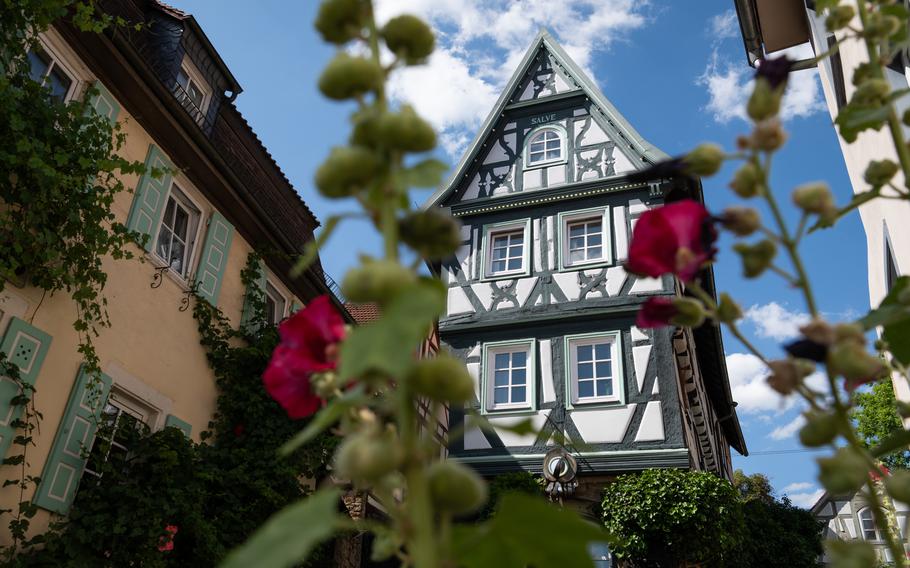
An old house in Bad Wimpfen, Germany. During a visit to the town in 1878, Mark Twain said, “it had queer houses 500 years old in it.” (Phillip Walter Wellman/Stars and Stripes)
Mark Twain once described Germany in summertime as “the perfection of the beautiful,” and in his 1880 travel book “A Tramp Abroad,” the American author praises a section of the Neckar River between Heilbronn and Heidelberg.
I retraced some of Twain’s footsteps with the help of his 140-year-old prose, noting the changes that occurred over the ensuing decades and the ancient beauty that remains.
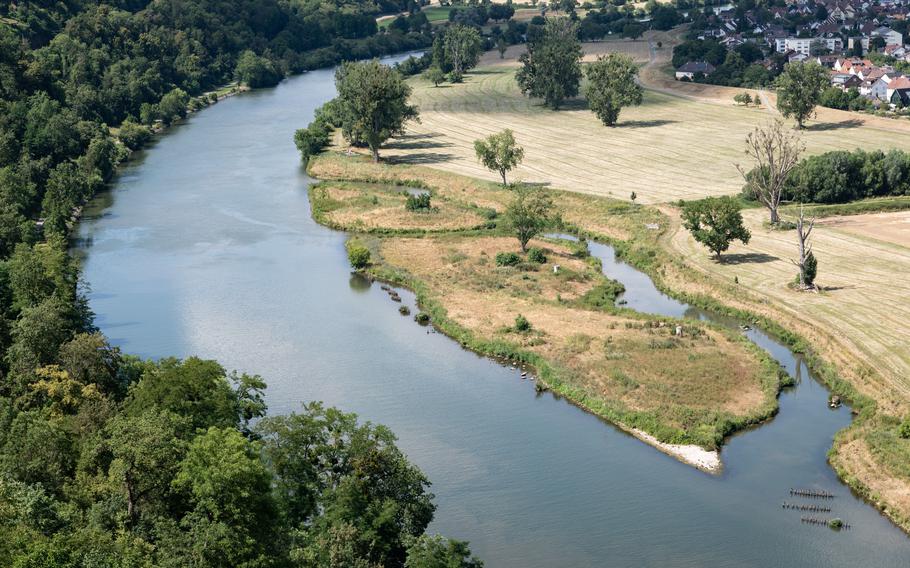
A section of the Neckar River in the German state of Baden-Wuerttemberg, July 6, 2023. (Phillip Walter Wellman/Stars and Stripes)
Heilbronn was the starting point. In the main square are the town hall “of the quaintest and most picturesque Middle-Age architecture,” and St. Kilian’s Church, “a curious old structure, with a towerlike spire adorned with all sorts of grotesque images.”
Both were destroyed during World War II and rebuilt. But they still match Twain’s description, including details of the hall’s gilded clock and the church’s bizarre gargoyles.
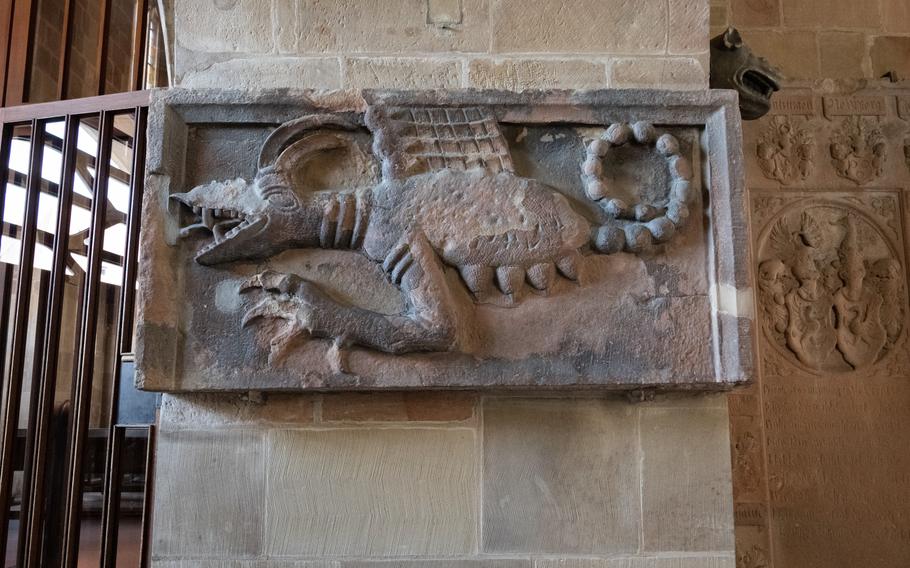
A dragon-like figure carved in stone is displayed inside St. Kilian’s Church, Heilbronn, Germany, July 6, 2023. (Phillip Walter Wellman/Stars and Stripes)
Stone carvings, including a dragonlike figure, are displayed inside the church. Those wishing to ascend the monument’s western tower, one of the first major Renaissance buildings north of the Alps, can pay a small fee to do so.
Across town, the Goetz Tower, formerly the Square Tower, survived the war. Twain wrongly names it as the site were the famous knight Goetz von Berlichingen was held for a night before being moved to his final holding place. In fact, von Berlichingen was kept in the nearby Bulwark Tower.
While it can be difficult to imagine what Heilbronn was like in Twain’s day, in Bad Wimpfen, about 15 minutes away by car, the task is easier. The “venerable old village” with “houses 500 years old in it” looks like it’s been the same for centuries.
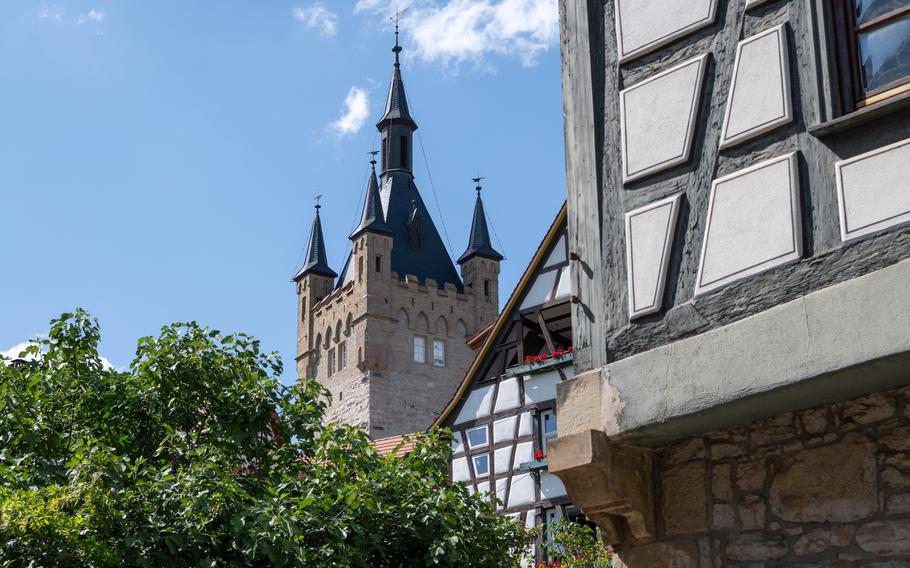
The Blue Tower in Bad Wimpfen, Germany, July 6, 2023. (Phillip Walter Wellman/Stars and Stripes)
The symbol of the town is the Blue Tower, which is said to have the oldest, uninterrupted watchman tradition in Germany.
Visitors who go up the 100-foot building likely will meet Blanca Knodel, the tower keeper, who has lived in a small apartment at the top for nearly 30 years and collects a fee from visitors who want to access the observation deck.
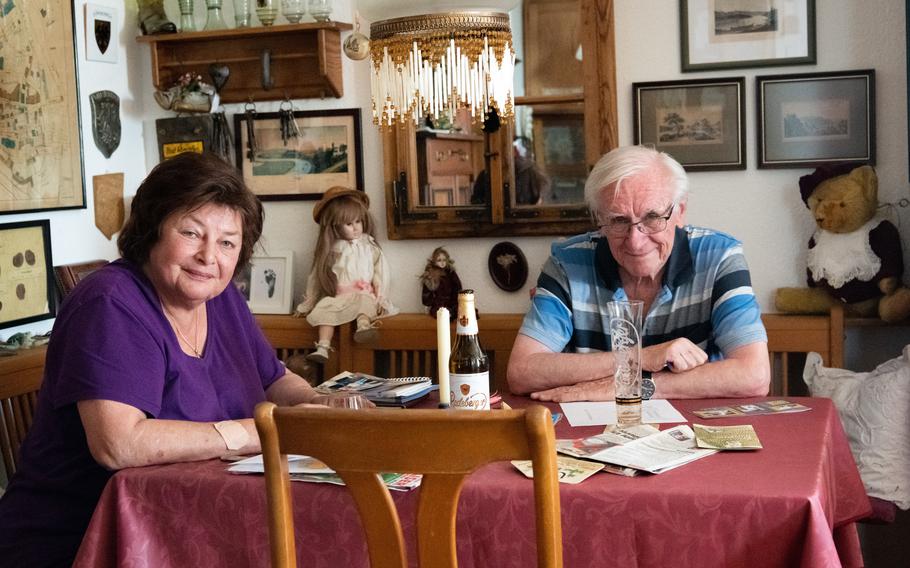
Blanca Knodel, tower keeper of the Blue Tower in Bad Wimpfen, Germany, left, and acquaintance Guenther Haberhauer pose for a photo at Knodel’s apartment inside the tower on July 6, 2023. (Phillip Walter Wellman/Stars and Stripes)
Twain mentions a 115-foot military tower in Bad Wimpfen. One would assume he’s referring to the Blue Tower. But a sketch included in “A Tramp Abroad” looks more like the less impressive Red Tower about 200 yards away, which also is open to visitors.
Next down the river is the partially ruined Hornberg Castle, which Twain mentions briefly. It’s the former home of von Berlichingen, the imprisoned knight. Visitors can roam the grounds and visit a small museum housing von Berlichingen’s armor.
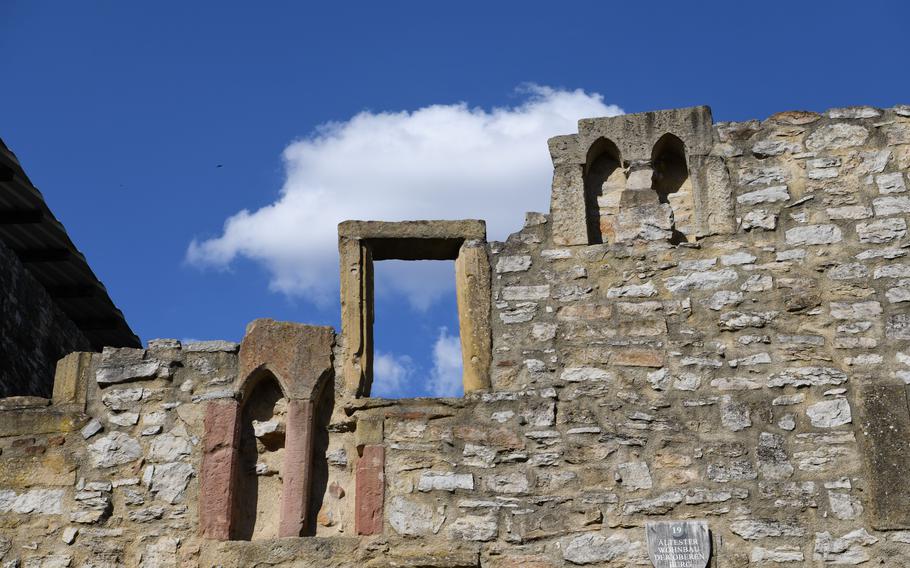
The Hornberg Castle ruins in Baden-Wuerttemberg, Germany, July 6, 2023. (Phillip Walter Wellman/Stars and Stripes)
I stopped for a quick walk along the Neckar, which Twain repeatedly extolled in his book, while driving to the next destination, Hirschhorn. Twain stayed in the Naturalist Tavern, a hotel adorned with taxidermy.
“I dozed off to sleep while contemplating a great white stuffed owl which was looking intently down on me from a high perch with the air of a person who thought he had met me before but could not make out for certain,” Twain wrote.
The hotel no longer exists, but the owl is on display at the Langbein Museum along with a stuffed cat Twain also mentioned. Hirschhorn castle and a nearby church Twain visited also are open to tourists.
The walled town of Dilsberg, about a 30-minute drive from Hirschhorn on the opposite side of the Neckar, is a highlight of the trip.
Centuries ago, the town was considered unconquerable, and potential captors couldn’t work out how residents replenished their food and weapons without access to the outside world.
During his visit, a group of children took Twain to the empty well of Dilsberg’s ruined castle and spoke of a local legend that said a tunnel was concealed inside.
Believers said the opposite end opened at a secret location and this is how residents were able to sneak in supplies.
After reading “A Tramp Abroad,” German-American Fritz von Briesen was inspired in the 1890s to travel to Dilsberg and rappel down the well. He discovered the tunnel, which had been filled.
The 260-foot-long passageway finally was cleared about two decades later, and today visitors can enter from the side of the hill.
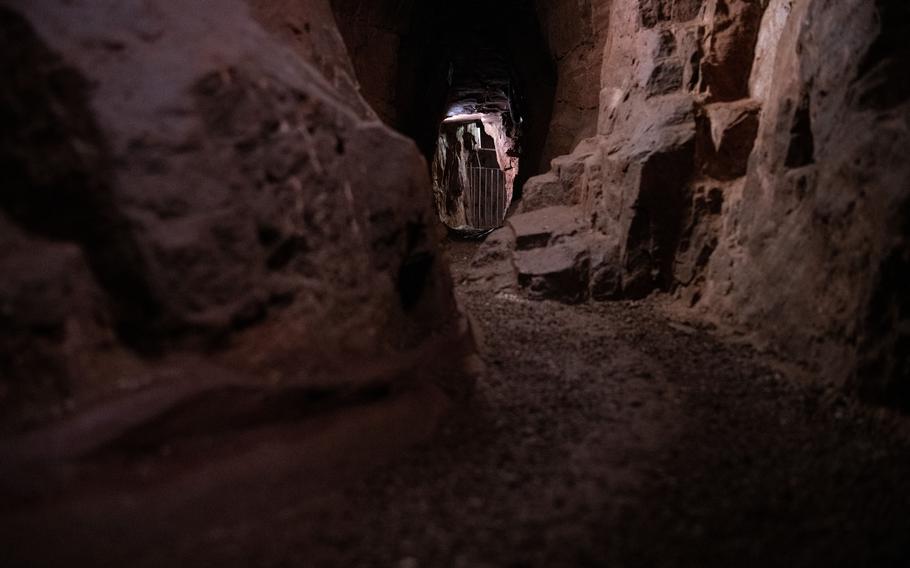
An underground passageway leading to the Dilsberg Castle well on July 8, 2023. The passageway was discovered by a reader of Mark Twain’s “A Tramp Abroad.” (Phillip Walter Wellman/Stars and Stripes)
Most historians believe that the tunnel was used for ventilation rather than as a way to smuggle in supplies. So the town retains some of its aura of mystery.
Heidelberg is the last stop on the tour. The Hirschgasse Hotel and Restaurant’s 15th century building used to hold brutal student sword fights, which Twain attended. A passage about them in “A Tramp Abroad” is one of the most interesting parts of the book.
The swashbuckling has been relegated to the past. But the highly rated German food at the Hirschgasse Hotel is a great way to end your Twain tour.
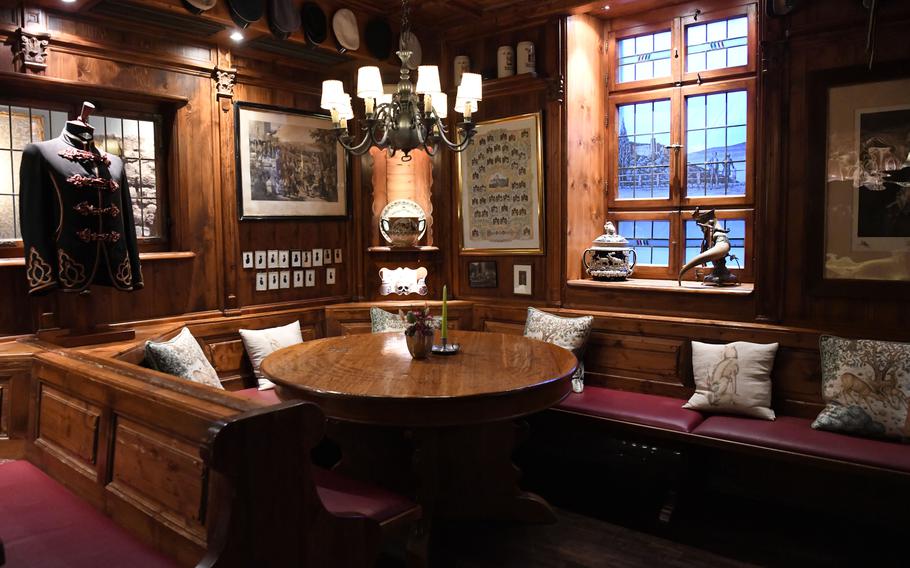
The Mensurstube restaurant inside the Hirschgasse Hotel celebrates the buildings swordfighting tradition. (Phillip Walter Wellman/Stars and Stripes)
On the QT
Addresses: St. Kilian’s Church, Kaiserstrasse 38, 74072 Heilbronn; Blue Tower, Burgviertel 9, 74206 Bad Wimpfen; Hornberg Castle: 3, 74865 Neckarzimmern; Langbein Museum, Alleeweg 2, 69434 Hirschhorn; Dilsberg Castle: Burghofweg 3a, 69151 Neckargemuend, Hirschgasse Hotel: Hirschgasse 3, 69120 Heidelberg
Hours: St. Kilian’s Church: daily 9:30 a.m. - 5 p.m., Blue Tower: Tuesday – Saturday 10 a.m. – 6 p.m., Hornberg Castle: daily 10 a.m. – 6 p.m., Langbein Museum: hours vary, Dilsberg Castle: Tuesday – Sunday 10 a.m. – 5:30 p.m.
Costs: Western tower St. Kilian’s Church, 2.50 euros; Blue Tower, 1.50 euros; Hornberg Castle, 7 euros; Langbein Museum, 3 euros adults, 2.50 euros children; Dilsberg Castle, 2 euros adults, 1 euro children.
Information: Hornberg Castle: burg-hotel-hornberg.de/en, Langbein Museum: museum-hirschhorn.de, Dilsberg Castle: www.burgfeste-dilsberg.de/en, Hirschgasse Hotel: hirschgasse.de/gastronomie-heidelberg